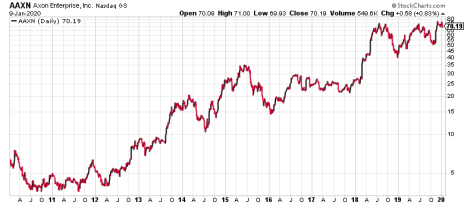You May Not Know the Name Axon Enterprise. But the Product is Familiar. And AAXN Stock is Worth Your Attention.
Everyone knows what a TASER is. It’s an electric stun gun that—ideally—incapacitates a victim who is contacted by its electric probes. Management now prefers to call them “conducted energy weapons.”
But not many people know the name Axon Enterprise (AAXN), which is the name that the Taser company chose as a new identity back in 2017.
To me, it’s similar to the way Philip Morris rebranded itself as Altria. It’s a way to shift attention from the negative connotations of the old name.
[text_ad]
Don’t get me wrong. I like Axon’s technology. I think it’s revolutionizing the world in the good way.
And I like investing in AAXN stock, especially when it’s strong.
For example, way back in November 2003, Cabot readers racked up profits of 296% in Axon Enterprise stock in just five months! Of course, Taser was much smaller then (the company had revenues of just $25 million that year) and my father was still calling the shots for our growth stock advisory, but that big fast profit shows the power of investing in a great new idea.
More recently, readers of my own Cabot Stock of the Week advisory bought the stock in April 2018 when it was selling at 43, and sold just five months later at 73 for a profit of 71%. Axon is a larger, slower-growing company now, so it’s natural that the profits grew more slowly.
But there have been long periods of time when it’s been wise to be out of the stock totally.
After my father’s big success, in fact, the stock actually declined for seven years, partly because of concerns about fatalities caused by the weapons and partly because the stock just needed to cool off after that red-hot performance.
And since I recommended selling AAXN in September 2018, the stock has made no net progress; it’s simply built a long base. In the long run this should be good, as it’s setting the stock up for another profitable run—and I’ll give you some suggestions on how to catch that next run farther on. But first let’s take a closer look at the company, because there are some very interesting aspects to the Axon Enterprise story.
Axon’s Mission
Axon’s Mission today is:
- Obsolete the Bullet
- Reduce Social Conflict.
- Enable a Fair & Effective Justice System
That’s all good.
Additionally, of course, like any company conscious of its shareholders, Axon is working to grow revenues and earnings.
And it’s done a good job of it, over the long run.
Over the past 10 years, revenues have grown from $104 million to $505 million (2019 estimate), while EPS has grown from -$0.01 to $1.01 (2019 estimate).
And the stock has done well over that time as well, rising from 4.40 to over 70.
But it hasn’t been a smooth ride, and part of the reason is that TASERs sometimes kill people.
Or, you might say that the people wielding the TASERs kill people.
It’s the same as with bullets, except TASERs are far less lethal.
Trivia Break:
The name Taser was originally “TSER,” an anagram of “Tom Swift Electric Rifle,” as portrayed in the 1911 book, “Tom Swift and His Electric Rifle.” The “a” was added to make the name easier to say and remember.
Diversifying into Cameras
So, just over a decade ago, the company got into the body camera business, reasoning that police departments who bought TASERs—and even those that didn’t—would welcome the opportunity to have video they could refer to after incidents. And—ideally—the knowledge that their actions were being recorded would provide an incentive for law enforcement personnel to act professionally.
Today, the company has more than 600,000 TASER weapons in place globally, and 47 of the 69 largest U.S. metro areas use the Axon camera solution, which encompasses body cams, dash cams and more. There’s also a growing international presence, with Australian forces in particular embracing the technology.
Bottom line, the move into the camera business not only diversified the company’s income stream, it also enabled a stream of recurring income from users of these cameras and the attendant software.
Today, 55% of Axon’s revenue comes from recurring contracts, and the vision of the company has shifted, so that cameras and the resulting video are at the core of the vision. In fact, the heart of the Axon video system is called Evidence.com. It’s a cloud-based video storage database where law enforcement personnel can store and retrieve evidence as needed.
The storage is easy.
At the end of a shift, the patrol officer docks the camera at the precinct and walks away. An internet-connected dock uploads the data to Axon’s secure cloud storage and recharges the battery. And when the camera blinks green, it’s ready to go back out on patrol.
Today, the company has sold 429,000 licenses for Evidence.com by emphasizing not only the ease of use of the integrated system but also the way it increases officer efficiency.
However, there’ s a fly in the ointment.
The Little Acquisition That Caused a Big Problem
In May 2018, Axon acquired its main competitor in the police body cam industry, Vievu, for $4.6 million in cash and $2.5 million in common stock. At the time, Vievu supplied body cam technology to police departments in cities like New York City, Miami, Oakland, Phoenix, and Aurora, Colorado. After the acquisition, Axon had 43 of 54 U.S. police department body cam contracts.
(Technically, Vievu at the time was part of Safariland, a provider of police and military safety equipment, and as part of the deal, Axon entered into a strategic relationship with Safariland that was intended to help both companies in the future.)
By all indications, the acquisition has been well integrated. However, the Federal Trade Commission (FTC) began investigating the acquisition in mid-2018, concerned about anti-competitive implications.
And on December 23, 2019, the FTC, claiming that the acquisition had allowed the company to impose substantial price increases, demanded that Axon divest the assets acquired in the Vievu acquisition and surrender its independently created intellectual property as part of a “blank check” to create a competing spinoff—or face an FTC proceeding.
But management at Axon didn’t like that idea.
So on January 3, Axon sued the FTC, asking the court to declare the FTC’s structure and administrative procedures unconstitutional, and enjoin the FTC from subjecting Axon to its unfair internal forum and instead adjudicate the legality of the Vievu acquisition in a federal court.
In short, Axon claims that Vievu, when acquired, was a small, failing company with a mountain of debt and only three days of cash.
It claims that the market for body cameras and digital evidence has remained competitive, with 10 competitors winning at least 55 sizable agency deals since the acquisition.
And it claims that the FTC’s use of an internal administrative proceeding violates Axon’s constitutional rights to due process and equal protection of law. (Over the past two years, the FTC has prevailed in all its cases. Reminds me a bit of the courts in Japan.)
In a statement, founder and CEO Rick Smith said, “No one should ever face the prospect of a government that can demand to seize your most precious assets without the ability to defend yourself in a fair and impartial court of law. If the FTC believes it has a strong case against us, it should prove it in federal court before a neutral judge. Our action today seeks to ensure that will happen.”
What happens next will be interesting. The only thing I’m confident about is that it will take a lot of time. In fact, the word “quagmire” comes to mind.
In the meantime, here are my current thoughts on investing in AAXN stock.
How to Invest in Axon Enterprise (AAXN)
One way to invest in Axon Enterprise stock is to buy and hold. Not only has AAXN stock been in a long-term uptrend since 2010, Axon dominates its industry and I believe that in the long run it will prevail—regardless of how this FTC case plays out. I love the recurring income aspect of the business, as well as the company’s future plans, which include increasing use of artificial intelligence to both view video and to dispatch officers when appropriate. In fact, I have called AAXN a forever stock – i.e. a stock that could be held “forever.”
But another way to invest in Axon is to delay buying until the stock shows true momentum, indicating that other investors are climbing on board. And if you can wait until the stock breaks above a previous resistance level and breaks out to new highs on big volume, even better. If you buy when momentum appears, however, you’ve got to get out when momentum fades.
That’s worked twice for Cabot so far and I was very close to recommending AAXN stock again in Cabot Stock of the Week when the FTC news came out. After all, the base that the stock had built since mid-2018 looked like a good set-up for the next advance. And the fundamentals still look fine.
But the FTC news sparked two days of high-volume selling and the stock’s rebound since then has been weak—telling us there’s not a lot of buying power among major investors today. So what I’m going to do is keep an eye on it, and that’s what I suggest you do too.
When the stock does break out—whether it’s next week or several years from now—you can depend on Cabot’s growth investing analysts to be on top of it.
[author_ad]



